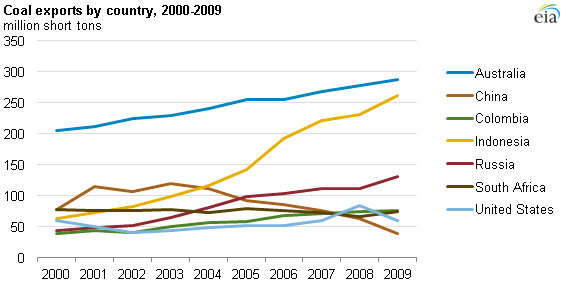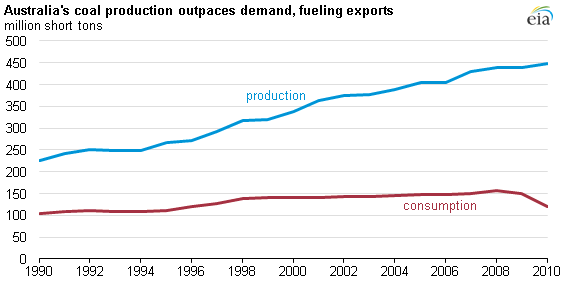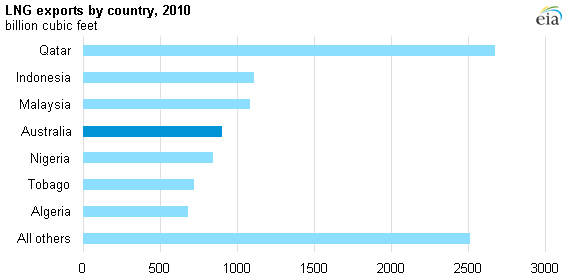
Australia world's largest coal exporter, fourth-largest liquefied natural gas exporter

In 2010, Australia was the world's largest coal exporter and fourth-largest liquefied natural gas exporter. Australia is one of the few countries in the Organization for Economic Cooperation and Development (OECD) that is a significant net hydrocarbon exporter, sending abroad about two-thirds of its total energy production. Energy exports accounted for 34% of total commodity export revenues. At $36 billion in 2010, coal represented over half of energy export revenue.
Australia produced 449 million short tons (MMst) of coal in 2010—about 40% of U.S. production—making Australia the world's fourth-largest coal producer, after China, the United States, and India. But Australia is the world's largest coal exporter, exporting about 70% of its coal production or nearly 300 MMst in 2010. Australia accounted for almost one-third of bituminous coal exports worldwide in 2010; a large share of this coal consisted of coking coal used for steel manufacture.
Japan is Australia's top export market for coal, accounting for about 43% of 2010 Australian coal exports. Other key markets include South Korea, China, India, and several countries in Europe.
Coal is Australia's largest export commodity, representing over one-half of energy export revenue. Coal production has doubled over the past two decades, driven in part by strong international demand growth and continued investment in export capacity. Production has outpaced coal consumption in Australia (see chart below). Since 2000, coal production is up 33% and domestic coal consumption is down 15%.

In early 2011, Australia's typhoon season had a large effect on coal producing regions, flooding mines, knocking out railroads and bridges, and damaging seaports. Damage was extensive and recovery has taken months, slowing production and exports. As a result, U.S. coal exports are at record highs as America and other nations fill the gap of the world's largest coal exporter. Recovery from earlier coal supply disruptions is on-going; Australia is reclaiming market share in the global coal trade and displacing some of the gains in U.S. exports.
In addition to coal, Australia is one of the world's leading exporters of liquefied natural gas (LNG). Australia produced 1.6 trillion cubic feet (Tcf) of natural gas in 2010. About one-half of total natural gas production is converted into LNG for export (0.8 Tcf of LNG in 2010, up from 0.7 Tcf in 2009). Japan receives the majority of Australian LNG exports (70%), with China, South Korea, and Taiwan importing most of the rest. Australia is the world's fourth-largest LNG exporter.

Australian LNG exports have increased by 60% over the past decade, and are expected to continue to increase in the near future. The expansion of the Asian LNG market has prompted several major new LNG projects, which will significantly increase Australia's LNG export capacity.
EIA's Country Analysis Brief on Australia contains additional information on the Australian energy industry.